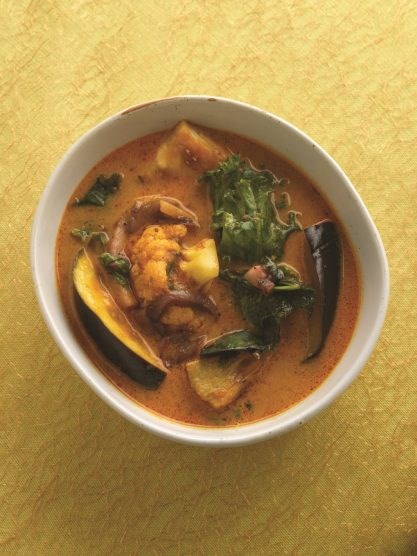Spice support: fenugreek
May 6, 2017 by Darcie
Many plants perform culinary double-duty: their leaves and their seeds are both used for various culinary purposes. That is the case with today’s selection, fenugreek. The Latin name for the herb is quite a mouthful – Trigonella foenum-graecum – and comes from the Latin “Greek hay”, according to Harold McGee in On Food and Cooking. It is also known as methi in India; kasuri methi is the term for dried fenugreek leaves. An annual in the bean family, fenugreek is commonly found in Indian and Middle Eastern cooking.
The leaves are used in curries, particularly those with potatoes and vegetables, and sometimes make appearances in flatbreads such as naan and paratha. The seeds are more widely used than the leaves and form an important part of many curry powders. According to The Herb Bible, sprouted fenugreek seeds can add a spicy tang to salads or a sandwich filling.
Fenugreek is somewhat bitter but has a sweet aroma with maple and caramel notes, which according to Harold McGee come from the chemical sotolon, which is also found in molasses, barley malt, and coffee. Although it is not frequently used in sweet applications, fenugreek is a key seasoning in faux maple syrup.
When the seeds are soaked, their outer layer produces a thick gel that lends a slippery mouthfeel to some condiments and sauces like the Yemenite hot relish hilbeh. Fenugreek is versatile, pairing well with many different spices in a variety of applications. In The Flavor Bible, Chef Vikram Vij says “I love fenugreek, and its incredible aromatics. It goes well with everything from chicken to vegetables.”
Recipes usually call for fenugreek seeds or for ground fenugreek. The seeds are small, octagonal, and very hard. The Encyclopedia of Spices and Herbs notes that if you plan to grind the seeds at home, you should first toast them to make them easier to grind (making sure not to overtoast lest the seeds become too bitter), and you are better off using a spice grinder rather than a mortar and pestle.
The EYB Library contains over 4,500 recipes that use fenugreek, found in a large number of cookbooks including recent works like My Modern Indian Kitchen by Nitisha Patel, Vibrant India by Chitra Agrawal, Provence to Pondicherry by Tessa Kiros, Vij’s Indian by Vikram Vij, Taste of Persia by Naomi Duguid, and The Cardamom Trail by Chetna Makan, as well as classics such as From Curries to Kebabs by Madhur Jaffrey and The New Book of Middle Eastern Food by Claudia Roden. Popular recipes featuring fenugreek in the EYB Library include:
Eggplant, kale and cauliflower curry from Vij’s
Indian by Vikram Vij (pictured top)
Spiced meatballs with pomegranate gravy from The
Georgian Table
Rasika’s
kerala fish curry from Washingtonian.com by Vikram
Sunderam
Gujarati
potatoes from Food Safari by Maeve O’Meara
North
Indian chicken curry from Indian for Everyone by
Anupy Singla
Spicy
spinach and potato curry from Tinned Tomatoes
Keralan
veggie curry, poppadums, rice & minty yoghurt From
Jamie’s 15-Minute Meals by Jamie Oliver
Old
Delhi-style butter chicken from Spice at Home by
Vivek Singh
Categories
- All Posts (6940)
- Antipasto (2135)
- Author Articles (247)
- Book News (935)
- Cookbook Giveaways (983)
- Cookbook Lovers (257)
- Cooking Tips (109)
- Culinary News (299)
- Food Biz People (552)
- Food Online (791)
- Holidays & Celebrations (272)
- New Cookbooks (149)
- Recipes (1500)
- Shelf Life With Susie (231)
- What's New on EYB (133)
Archives
Latest Comments
- ccav on What foods do you look forward to the most for each season?
- ccav on Danube Cookbook Review and Giveaway
- hibeez on How cookbooks can help build resilience
- Pamsy on What foods do you look forward to the most for each season?
- Pamsy on How cookbooks can help build resilience
- DarcyVaughn on Danube Cookbook Review and Giveaway
- hettar7 on JoyFull – Cookbook Review & Giveaway
- eliza on What foods do you look forward to the most for each season?
- kmwyman on Rooza by Nadiya Hussain – Cookbook Review and Giveaway
- Maryd8822 on The Golden Wok – Cookbook Giveaway